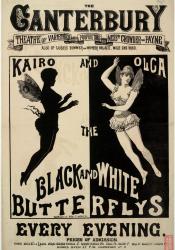Music Halls Become Popular Culture
Through the 1800’s, music halls transformed from established frequented only by the wealthy, to providing entertainment which marketed to, and enticed, a broad spectrum of British society. By paying as little as one penny (with many shows only asking two or three pence), a man, woman, or child of any socioeconomic class was welcomed to a packed, often smoky and even boozy music hall which featured a myriad of attractions ranging from samples from popular operas, to acrobatics, and magic shows. Many performances sought to relate to the everyday lives of patrons, featuring songs written for contemporary audiences. Music halls were unique in that they were respectable entertainment (as opposed to variety shows common to London’s East-End), but affordable to most people (as opposed to operas and the like). The mainstreaming of music halls is an example of how culture began to transgress ordinary class divides.
The included image is an advertising broadsheet for two entertainers who, with the help of wires that were allegedly invisible to the audience, flew throughout the halls as part of their spectacle. The show was featured at the Canterbury music hall, which opened in 1850. Similar advertisements, seeking a broad audience, would have been posted throughout London as well as in the little magazines covered in this course.
Sources
Picard, L. (2014, February 14). Popular culture. Retrieved from https://www.bl.uk/victorian-britain/articles/popular-culture
Poster advertising Kairo and Olga, the black and white butterflys, at the Canterbury Theatre of Varieties, London. (2014, April 23). Retrieved from https://www.bl.uk/collection-items/poster-advertising-kairo-and-olga-the...

